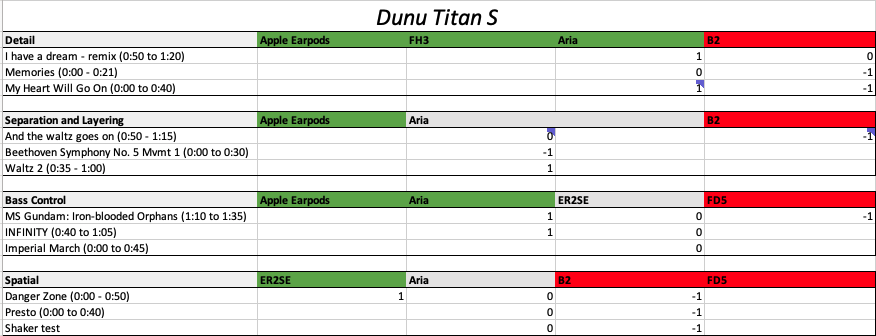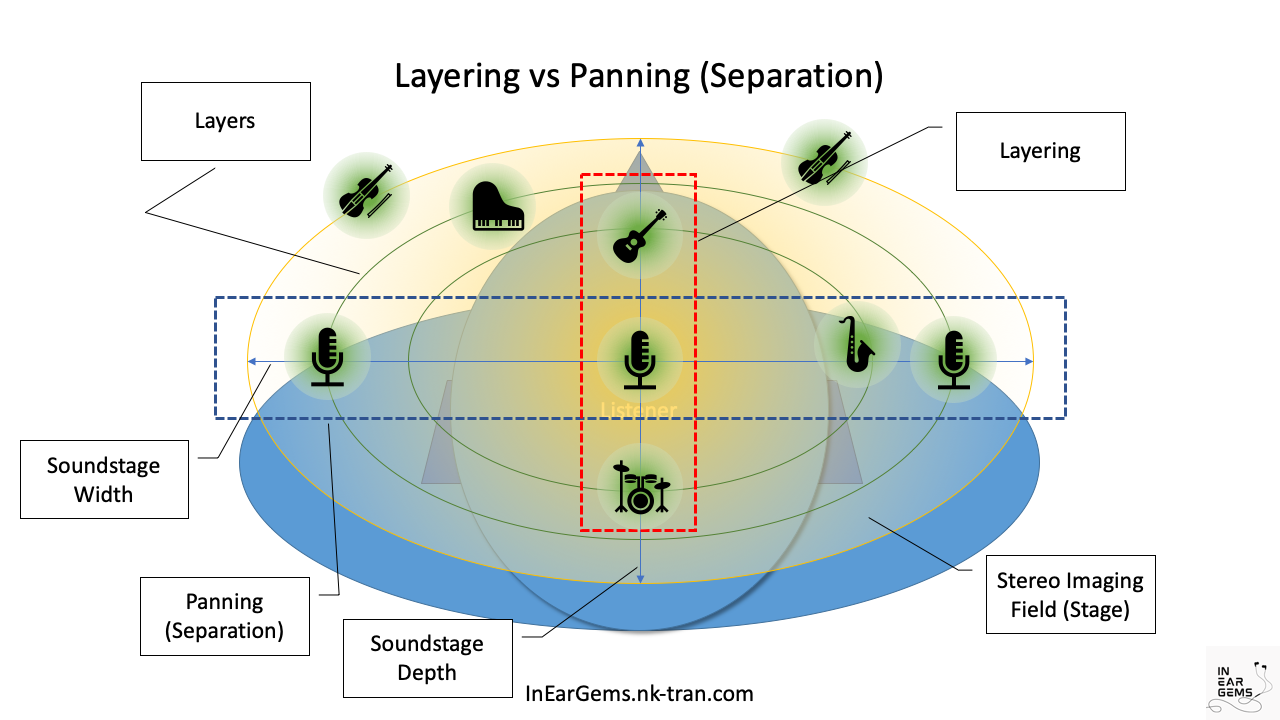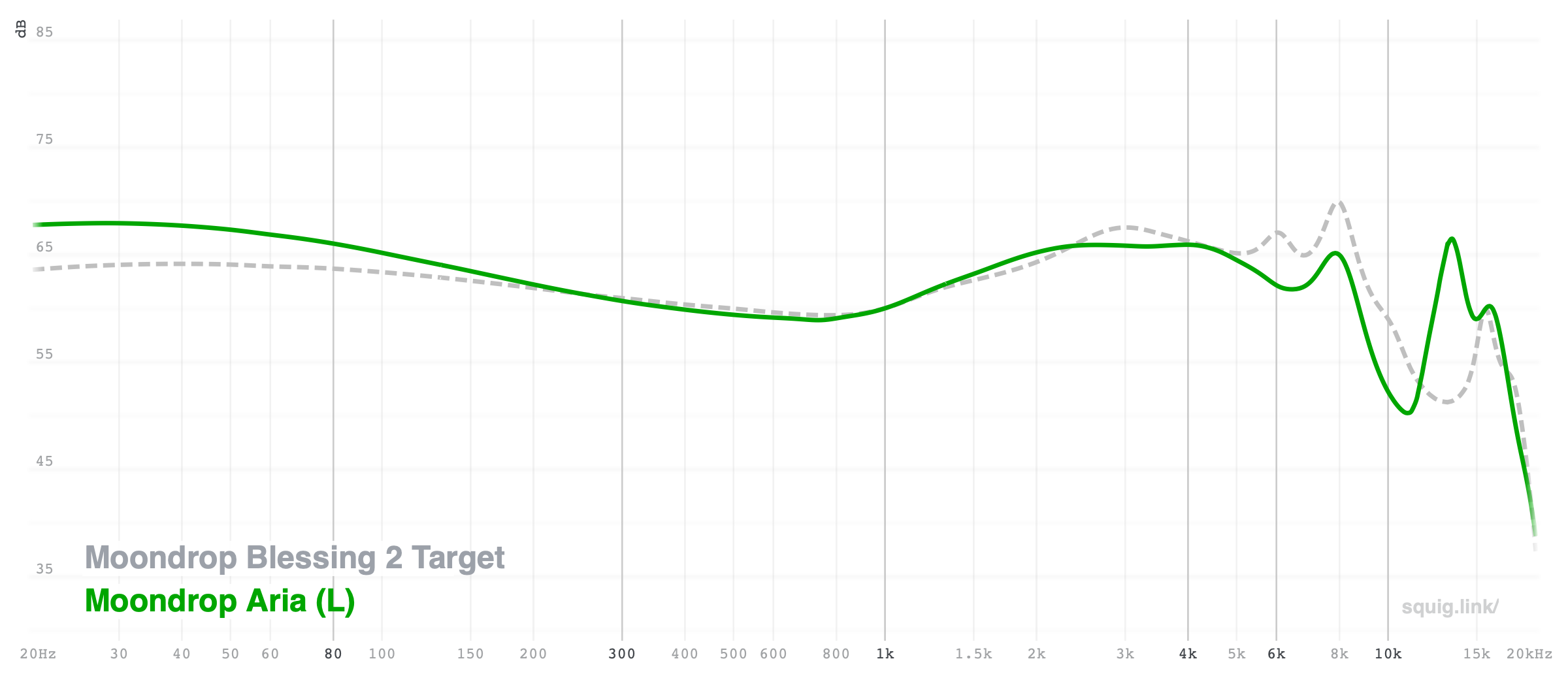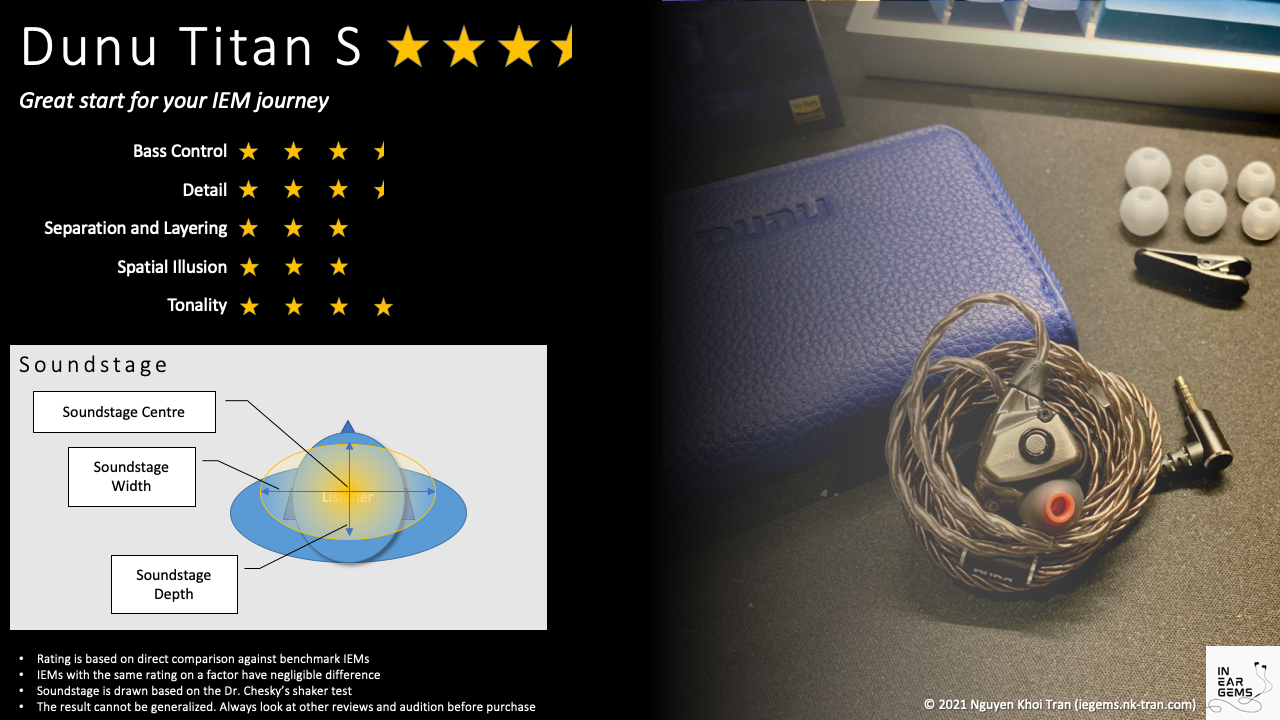Dunu Titan S - Vanilla Ice Cream
tl;dr: The best description of Titan S is that it sounds right: timbre is realistic, frequency response is not too warm nor cold, separation and micro-dynamic are adequate, drums are adequately tactile and snappy. The key limitation is that it does not sound special: no extreme detail, no exaggerated soundstage, no epic bass. Still, it represents excellent value and an excellent beginning of an IEM journey.
Preample
- I purchase this unit on my own. I have no affiliation with or financial interest in Dunu.
- All listening tests were conducted at around 65 dB.
- My music library covers nostalgic pop music, epic orchestral music from Sci-fi shows, classical violin performances, piano, lo-fi beats, and a few rock songs.
- What I look for in IEM, in order of importance: a strong sense of depth with elements in a mix layering from closer to further away, clear separation between elements, detailed and textured elements, snappy and tactile note attacks in bass and midrange, natural timbre.
- IEMs are rated with a series of A/B tests against a few benchmark IEMs. The total rating is the average of component ratings. EQ is NOT used in these tests. See the methodology for more detail.
- Eartips can change the insertion depth of an IEM, which in turn changes its soundstage and frequency response. I try to insert IEMs to rest against the concha of my ears unless indicated otherwise.
Non-sound aspects
Dunu announces Titan S by the end of 2021. It seems to replace the Dunu DM-480 as the most budget-friendly option in their current lineup.
Titan S is equipped with a single 11mm dynamic driver. Unfortunately, it does not use the ECLIPSƎ technology featured in other DD IEM from Dunu, such as Luna, Zen, and Falcon Pro.
Titan S comes with a lot of accessories:
- 10 pairs of ear tips: they have different heights, which can change the distance between the IEM and your ear and impact the soundstage.
- Carrying case: good quality, but quite flat. You have to be careful when putting the IEMs in because their nozzles might prevent closing the case.
- 2-pin cable: very soft and well-behaved. The 2-pin side matches the design of the IEMs, so changing the cable might not be a good idea.
Design-wise, Titan S has a unique look. However, it does not look as good in real life as 3D renders. Its angles are not as defined, the ridges of the IEM and the cable do not match exactly, and there is a seam line going down on the side of the IEM. On the plus side, the metal seems strong and does not use any paint. Thus, chipping and bubbling might not be an issue.
Fit-wise, Titan S has at least three insertion depths due to having long nozzles.
The blue eartips give you the shallowest insertion, with the IEMs resting at the outer edge of your ear canal. The red eartips allow for a medium insertion depth. The small white eartips allow for deep insertion, similarly to Etymotic IEMs. In this position, Titan S rest against the concha of my ears.
The deeper your fit is, the more clarity and detail you get at the expense of soundstage. In this review, I use the medium insertion depth.
Sound Analysis

Percussion Control: 3.5/5
Percussion control reflects an IEM’s ability to render drums and other instruments that maintain the rhythm and tempo. IEMs with good percussion control can keep up with fast and complex rhythms without blurring the beats together. IEMs with excellent percussion control also gives a tactile “snap” to percussion attacks. Percussion control is determined by both bass and treble.
Song list:
- MS Gundam: Iron-blooded Orphans (1:10 to 1:35): focus on the timing and composure of the bass line during busy section.
- INFINITY (0:40 to 1:05): focus on the timing of bass and cymbal.
- Imperial March (0:00 to 0:45): focus on the timing of percussion and double bass.
A strength of Titan S is the way it renders percussion instruments. It does not mean that Titan S has loud bass. Instead, it offers the proper ratio of sub-bass (rumble), midbass (punch), and treble around 4-6k (attack) to make drum hits snappy and energetic yet clean.
It has no trouble keeping with the chaotic sections from 1:10 to 1:35 in MS Gundam: Iron-blooded Orphans and 0:40 to 1:05 in INFINITY. The low-end and high-end percussion hits remain distinctive and rhythmic with the minimal mushiness.
Comparison against benchmark IEMs:
- Titan S renders percussion instruments similarly to ER2SE but louder and a bit more tactile, meaning you feel the hits in your eardrums more.
- Titan S renders drum hits cleaner and snappier than Aria. As a result, it remains more composed in difficult percussion sections.
- Titan S is one step behind FD5 in terms of energy and the physical impact of percussion instruments.
Detail, Texture, and Micro-dynamic: 3.5/5
Detail, Texture, and Micro-dynamic reflect an IEM’s ability to render fine details in individual elements of a mix. IEMs with excellent detail retrieval render vocal and instruments clearly and reveal small details such as breaths, small vibratos, and the subtle reverb at the end of a musical phrase. They can make the violin section in an orchestra sound like a collection of violins playing together rather than a blob of sound. They also render background elements such as backing vocal and orchestra clearly.
Song list:
- I have a dream - remix (0:50 to 1:20): focusing on small elements and backing vocal in the background of the mix.
- Memories (0:00 - 0:21): focusing on the texture and micro-details of the guitar.
- My Heart Will Go On (0:00 to 0:40): focusing on the texture and micro-details of the voice, especially the last words of each phrase.
Titan S is average at detail retrieval and micro-dynamic. The vocal and instruments do not feel overly smoothened. At the same time, it does not stand out in this aspect.
If I have to nitpick, I would say Titan S is a bit lacking in terms of the subtle reverb and decay at the end of notes. Luckily, it has a lean and revealing tuning, so this limitation does not stand out unless you look for it.
Comparison against benchmark IEMs:
- Titan S sounds a bit more revealing than Aria due to the tuning. However, Aria does a bit better in the subtle reverb and decay at the end of notes. The A/B tests show that Titan S wins, but I would not purchase based on this slight difference.
- Titan S has no chance against Blessing 2, which has similarly lean tuning and better micro details. Of course, Titan S would also lose to ER2SE, which trades blow with Blessing 2 on this aspect.
Separation and Layering: 3/5
Separation and layering reflects an IEM’s ability to distinctively render elements in a mix. IEMs with excellent separation and layering can separate elements from left to right and from front to back, minimising the overlap between them.

Song list:
- And the waltz goes on (0:50 - 0:15): focus on the layering and separation of the instrument.
- Beethoven Symphony No. 5 Mvmt 1 (0:00 to 0:30): focus on the sharpness of instruments, layering of woodwind over the string, and the panning of string from right to the left channel.
- Waltz 2 (0:35 - 1:00): focus on the separation and layering of woodwind over string over percussion.
Titan S is average at separation and layering. It renders elements in a mix with minimal blending and overlap. The stage remains organised when the music gets busy.
The limitation is that it does not layer well. For example, it fails to distinct orchestral sections in And the waltz goes on (0:50 - 1:15) because this piece does not spread elements from left to right but layers them up from closer to farther at the middle of the stage.
Comparison against benchmark IEMs:
- Surprisingly, Titan S does not do better than Aria at separation and layering, despite having a leaner tuning.
- Titan S is entirely outclassed by Blessing 2 and FD5, which can actually do the layering in And the waltz goes on.
Spatial Illusion: 3/5
Spatial illusion reflects an IEM’s ability to construct an imaginary sound field around a listener’s head. IEMs with excellent spatial illusion create a dome-like and open soundstage around the listener’s head.

Song list:
- Danger Zone (0:00 - 0:50): focus on the centre of the soundstage to see how much it is pushed away from the head.
- Presto (0:00 to 0:40): focus on the reverb. Does it wrap around the head or appear inside the head?
- Shaker test: for drawing out the overall shape of the soundstage.
The soundstage of Titan S is average in the world of IEM. It’s not surprisingly bad but does exceed the expectations of a vented IEM.
The soundstage width of Titan S varies from medium to wide, depending on your insertion depth. The soundstage depth is not exceptional. The stage does not feel wide open like other semi-open IEMs. The whole soundstage is slightly pushed away from the head, so the music does not sound inside your head.
Comparison against benchmark IEMs:
- Titan S soundstage is more or less the same as Aria.
- Due to the lack of depth, Titan S is entirely outclassed by Blessing 2 and FD5.
Tonality: 4/5
Tonality reflects the timbre and relative loudness of different elements in a mix. I assess IEM’s tonality based on how bad they are rather than how good they are. As long as the tuning does not make timbre unrealistic nor reduce technical performance significantly, it is acceptable.

Titan S sounds right. Vocal and instruments sound natural and have appropriate weight. I did not hear any honkiness or nasally tone. Titan S does not have an overly lean tonality, but it is undoubtedly less warm than expected. The biggest praise I can give Titan S is that I haven’t found the need to EQ it. Not even adding a bass shelf.
Comparison against benchmark IEMs:
- Titan S is leaner and cleaner than Aria.
- Titan S’s tuning is closer to Blessing 2.
Upgrade path
Should you get Titan S if …
- you have no IEM? Get it. It presents excellent value and shows you how a competent IEM should sound. From there, you can branch out and find the signature that you like.
- you have a not-so-great budget IEM? Get it. Same reasons as above.
- you already have something decent like Aria? Saving up for something better instead. You don’t gain much with Titan S, except better cable and perhaps more durability.
- you already have Blessing 2 or higher-end IEM? If you want to write a review, then yeah, get one.
- you want head-shaking, thick, boomy sound? No. Titan S does not offer that kind of sound signature.
Where to go from Titan S?
- More clarity? Moondrop Blessing 2 / Blessing 2 Dusk or Etymotic ER2SE
- More immersive soundstage? FD5 and Final A4000
- More impactful bass? FD5

